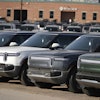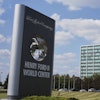
Karcher
Food manufacturers are always looking for the safest, most economical solutions to
keep their plant operations running smoothly. Selecting the right cleaning solutions for
large food production environments can be a challenge. Cost, emissions, and mainte-
nance, among many others, are all factors that figure into just how a manufacturer of
food products keeps its facility clean and free of pollutants.
The evolution of battery technology has improved cleaning solutions for use in environ-
ments that necessitate zero emissions. Battery powered sweeping, scrubbing and
vacuuming machines are great for certain situations, but are they right for your plant?
Let’s have a look.
Whether you’re looking at forklifts or ride-on cleaning equipment, such as sweepers,
scrubbers and vacuums, you’ve likely seen comparable battery-operated and Liquefied
Petroleum Gas (LPG) models in these categories. When deciding which is right for your
facility, you might take a number of factors into account.
Emissions
In the context of emissions, the size and layout of your facility, as
well as the number of machines you’ll need, may be important
as you make your decision. If your facility is smaller and features
cramped aisles and more constrained spaces, you might want
to avoid emissions altogether, which would favor battery
operated equipment, as these are zero-emissions machines.
Facilities that produce food and other environmentally sensitive
goods might also want to avoid emissions contamination.
Battery operated electric cleaning vehicles might also mitigate
cost associated with installing expensive HVAC filtering and
ventilation systems.
Battery Powered Vs. LPG Cleaning
Solutions: Which Is Right for Your
Food Manufacturing Facility?
In larger, open spaces, where there is a lot of square footage and multiple shifts, an
LPG model might be the best choice, as propane canisters can be easily replaced at
the end of every shift, while batteries will need to be charged. This might be particular-
ly applicable in warehouses and other operations that use these types of equipment
for hours at a time.
Mark McCullough, a product manager for Kärcher, which makes various ride-on
cleaning and maintenance machines, notes this difference.
“Obviously, the time to swap-out an LPG tank is a matter of a few minutes, whereas
the batteries can take up to 8 hours to fully recharge,” McCullough said.
Here are some battery and
tank ranges for the Kärcher
Ride-On Sweeper models.
Noise
Manufacturing facilities are already noisy places, which can inhibit communication and add unnecessary
confusion to a fast-paced workplace.
Battery operated equipment is very quiet,
usually in the mid-60 decibel range. Bat-
tery-operated ride-on scrubbers, sweepers
and vacuum systems won’t add to the
cacophony of the average facility. LPG or
other reciprocating engine driven equip-
ment may require the operator to wear
hearing protection as the decibel ranges
are well into the 70s.
Bryan Kucinski, director of Industry and
Transport for Kärcher, pointed to noise
and emissions as two key advantages to
battery powered machines.
“There’s a lot of advantages to a battery
powered machine,” Kucinski said. “One is
emissions, and the other is noise. When
you go into food and beverage where you
can’t have emissions, that’s where the advantage is.”
Battery Run Time LPG (33lb.)
KM 125/130 2.9 – 3.9 hrs 3.3 hrs
KM 130/300 2.5 – 3.0 hrs 3.3 hrs
KM 150/500 3.5 – 4.0 hrs 3.0 hrs
Cost
Initial cost and the cost of operation might be another factor to consider. The current market of cheap fuel
might help keep down day-to-day operations costs on LPG machines, and electric machines typically carry
a higher initial price point.
List prices for Kärcher Ride-On Sweepers
mentioned earlier. The KM 150/500
machine is the only battery-powered
machine in its size class.
*Prices provided by Kärcher.
The graph below, published in a blog by forklift maker Hyster and provided by NACCO, compares the cost
of ownership between a battery-powered forklift and an LPG forklift over the course of five years.
As noted above, the initial costs
of a battery operated machine
are higher than an LPG model.
Context
The type of cleaning and maintenance equipment any business invests in will ultimately depend on a
given business’ needs and applications. When considering options, remember to think through the
details of your operations:
Karcher is a leading provider of
battery-powered cleaning solutions
for the food manufacturing industry.
www.Karcher.com/US
• Size and layout of your facilities
• Number of machines you’ll be purchasing
• Proximity machines will be operating to workers
• Duration of use
• Initial cost
• Cost of ownership
• Sterility requirements for my products
• Effects on environment
Cost
(000s)
LP Gas Electric
Battery LPG
KM 125/130 $34,730 $31,750
KM 130/300 $44,500 $38,000
KM 150/500* $67,500 $50,000






















